Interview: Laura Zurowski (Mis-steps) on Making Art About the Iconic Public Stairways of Pittsburgh
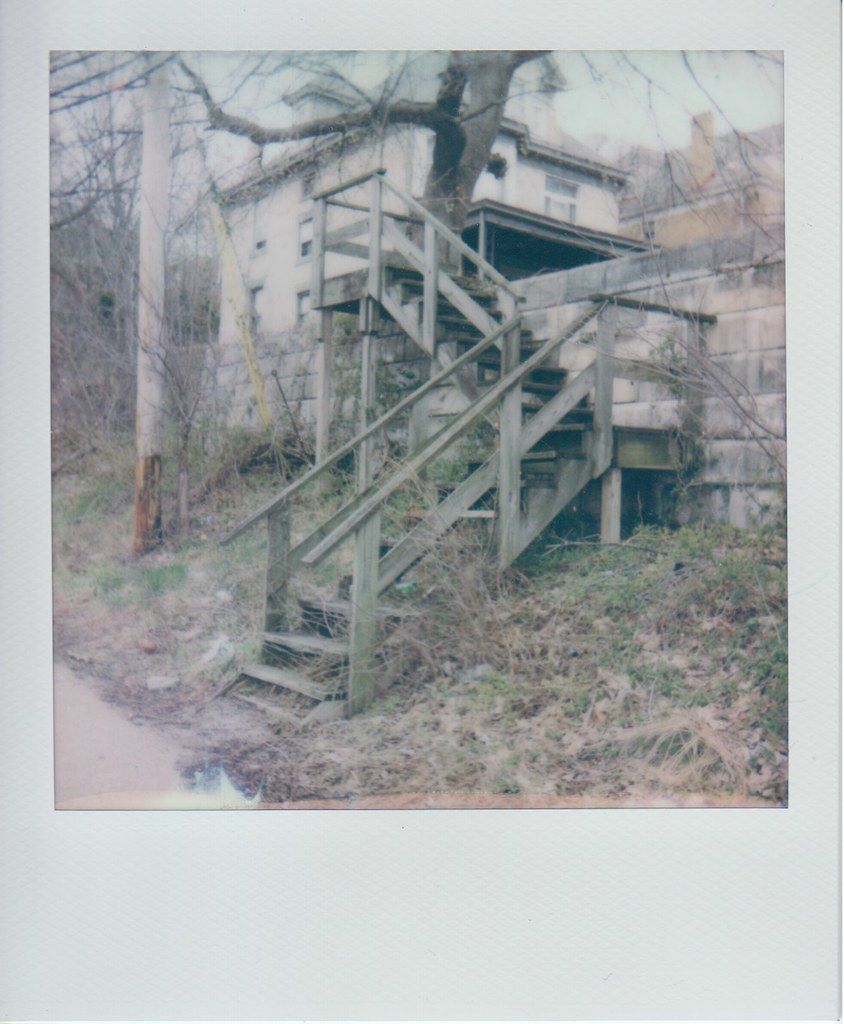
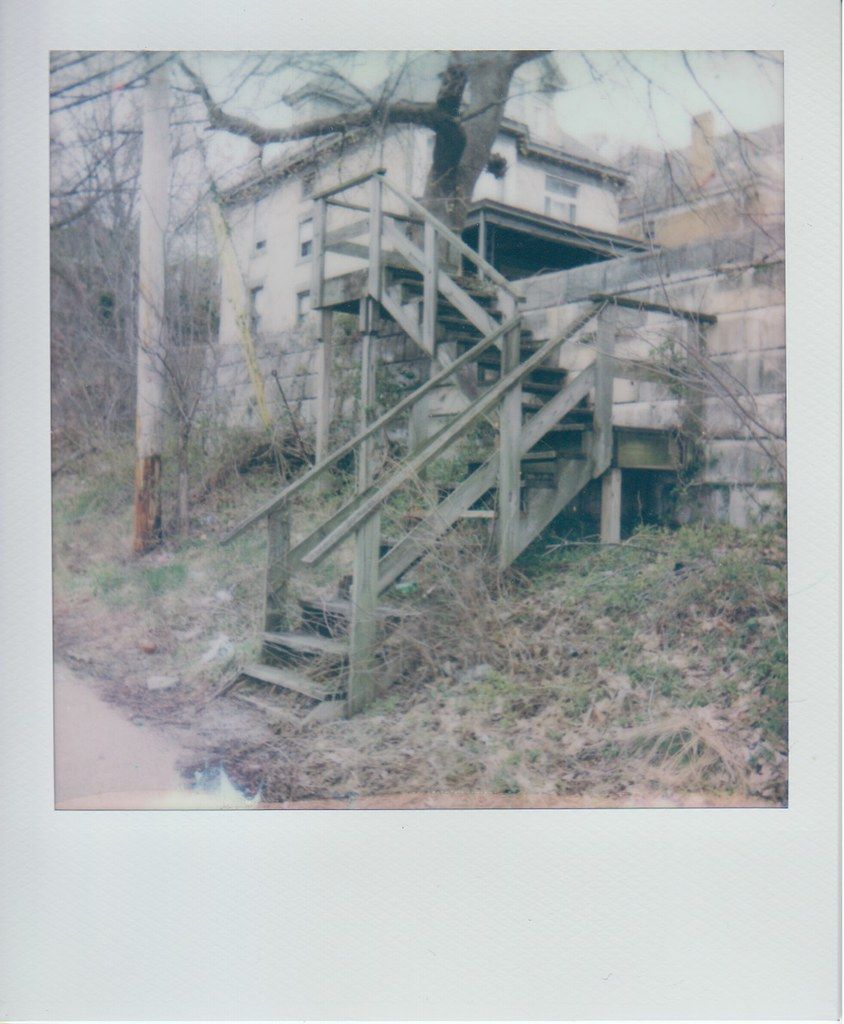
Over the course of the last couple of years there have been a few pillar topics and themes that have driven my own work forward around walking and infrastructure. When I was introduced to Laura Zurowski's project on the Pittsburgh steps I recognized so many of those themes that fireworks went off in my mind, along with a huge rush of excitement knowing that another artist was pursuing an obessive project of this nature and doing it in such an inspirational way.
What did I see that got me so excited?
- First, it's a project focused on pedestrian infrastructure: the Pittsburgh steps which have an important legacy in the city.
- Second, I recognized the obsessive pursuit in the project, the desire to complete and archive these visits to the steps.
- Third, Laura didn't just visit and document the steps, she turned those visits into art, with her own spin by making the polaroids and pairing them with short stories/essays based on her impressions in the moment at the steps.
- Fourth, while Laura documented the project on a blog, the final object for the project are a series of zines. I love that transformation!
- Lastly, Laura's project is based on archival material from a book about the steps, which you'll learn more about in the interview.
Before moving on, I want to say that this conversation happened several months ago, and because of my lack of focus on the newsletter, I am just getting around to publishing it now. Since then, Laura has made many more visits to the steps so when you visit these sights you'll receive a more complete perspective on the project.
Sometimes these encounters need time to settle, and the beauty of Laura's project and wise words about are they will be just as relavant today as they were last year and will be in several years. That's another reason I love these type or achival projects about public spaces. Time marches and these spaces will transform and evolve, which makes the historical record even more important, inspirational and interesting.
Bio: Laura Zurowski is a Pittsburgh-based writer/photographer.
In early 2017, I started Mis.Steps: Our Missed Connections with Pittsburgh’s City Steps as a way to re-discover these many stairs. What started as a simple “document the stairs” project very quickly morphed into something bigger. As I shared my photographs and stories, people responded both to the words and the images. People who are new to Pittsburgh and lifelong residents. People who moved away for better jobs. People who have a soft spot for Rust Belt grit. And a few people who are structural engineers and retired DPW employees
IG: @mis.steps
Twitter: @lzurowski
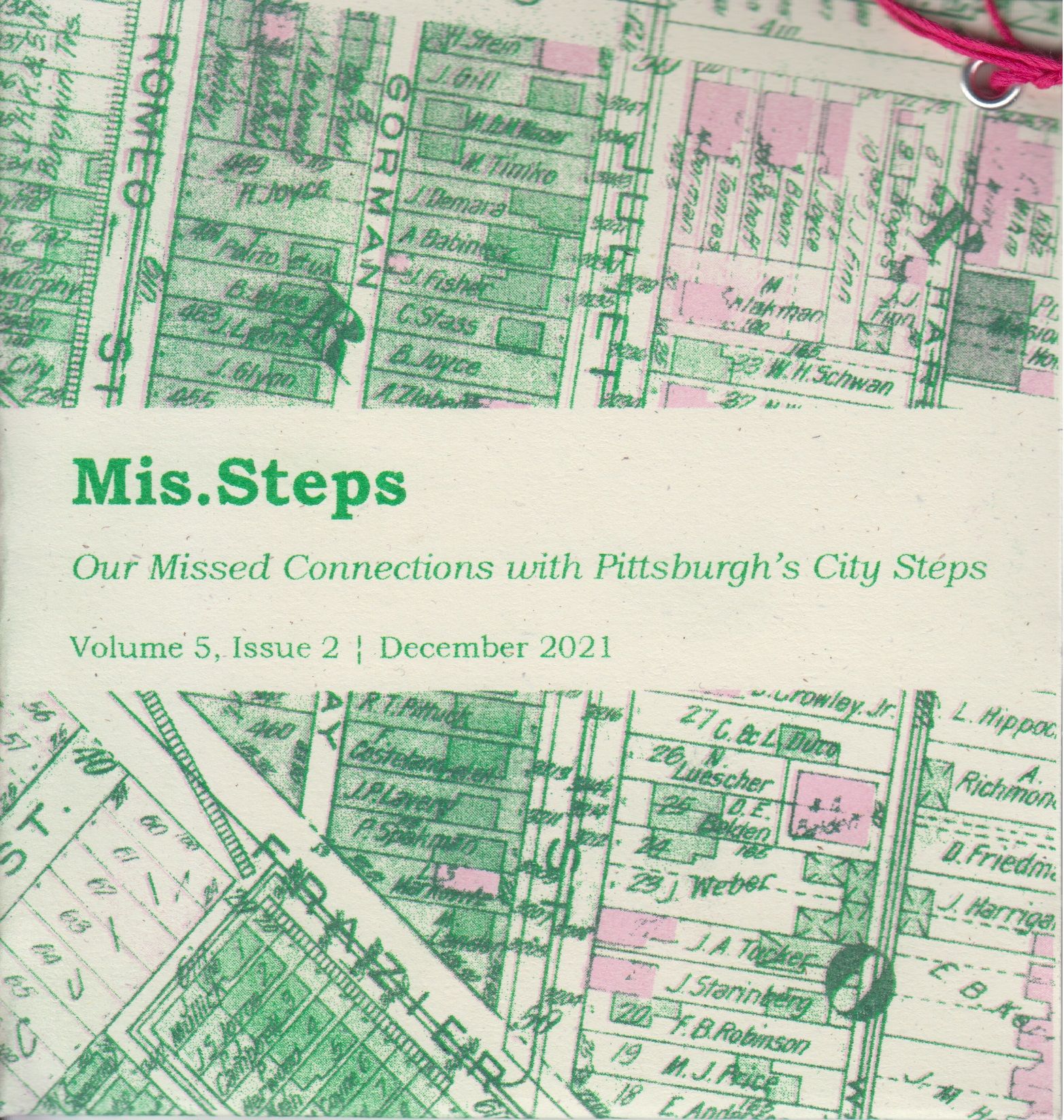
Hi Laura! Thanks for joining me. I discovered your project through my friend Alex Wolfe, and was fascinated right away.
It brought together a few elements I've been interested in for the last few years: pedestrian infrastructure, city history, walking, ritual documentation, film photography and self-publishing! That's a great mix. The project is based on the "739 city stairs listed in Bob Regan’s book, Pittsburgh Steps."
How did you know you wanted to pursue this project and how long did you deliberate on it?
I had been living in Pittsburgh for a few years and was starting to feel like I wasn't fully connected to the place. I'm from Providence, RI - a small city in the nation's smallest state - so I'm accustomed to being familiar with where everything is and how to get places. I was NOT feeling that way about Pittsburgh and it bothered me.
Around that time, I came upon Bob Regan's Book "Pittsburgh Steps: The Story of the City's Public Stairways" (Globe Pequot, 2015) in a local shop. The neighborhood I live in has several sets of public stairways so I was familiar with
them, but I hadn't realized just how plentiful they were in the city. When I read through the book, I thought to myself, "This is it!" I knew this could be a long-term creative project that would combine getting
out to explore the entire city.

I didn't deliberate very long and started making preparations almost immediately! I had been wanting to purchase a refurbished Polaroid Spectra through the Impossible Project but couldn't justify the cost of the camera and film until I had a solid reason to. The Spectra's combination of landscape and portrait is the perfect blend for Mis.Steps and I'm so glad I trusted my instincts on the message and sentiment it would convey. (And I'm hoping my stash of film I hoarded when the "new Polaroid" discontinued it holds out for another year... working with now expired film is tricky and frustrating - but that's for another story!)
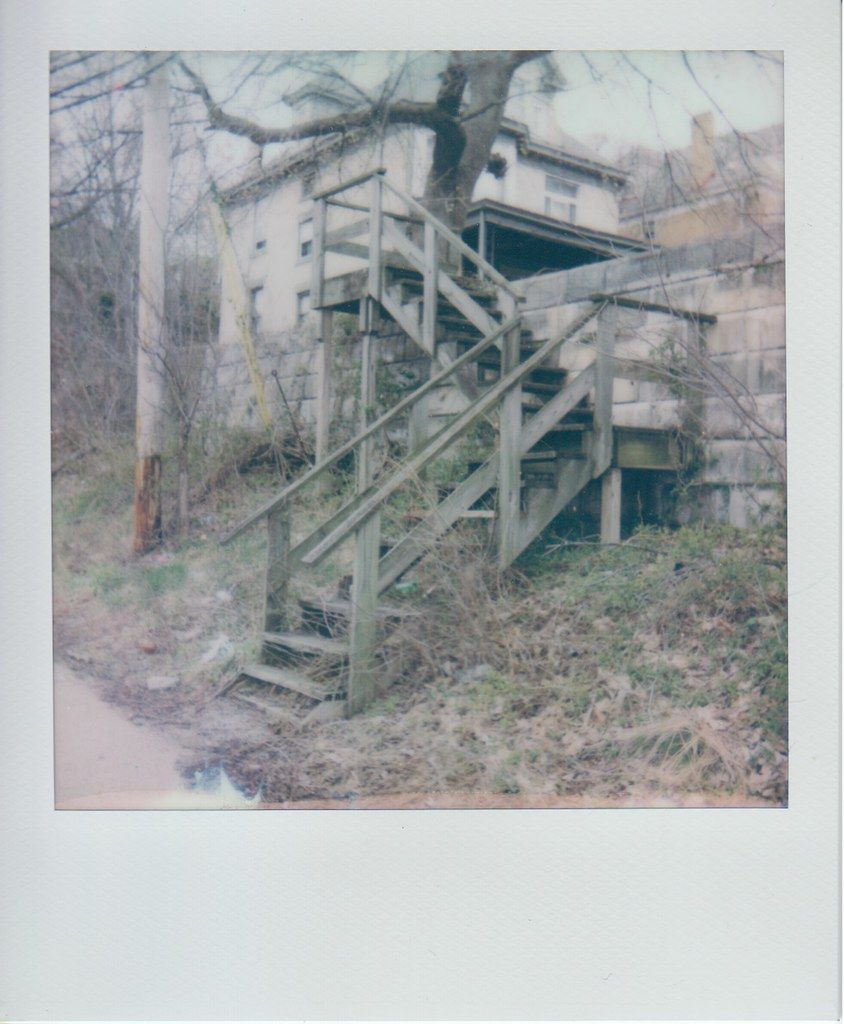
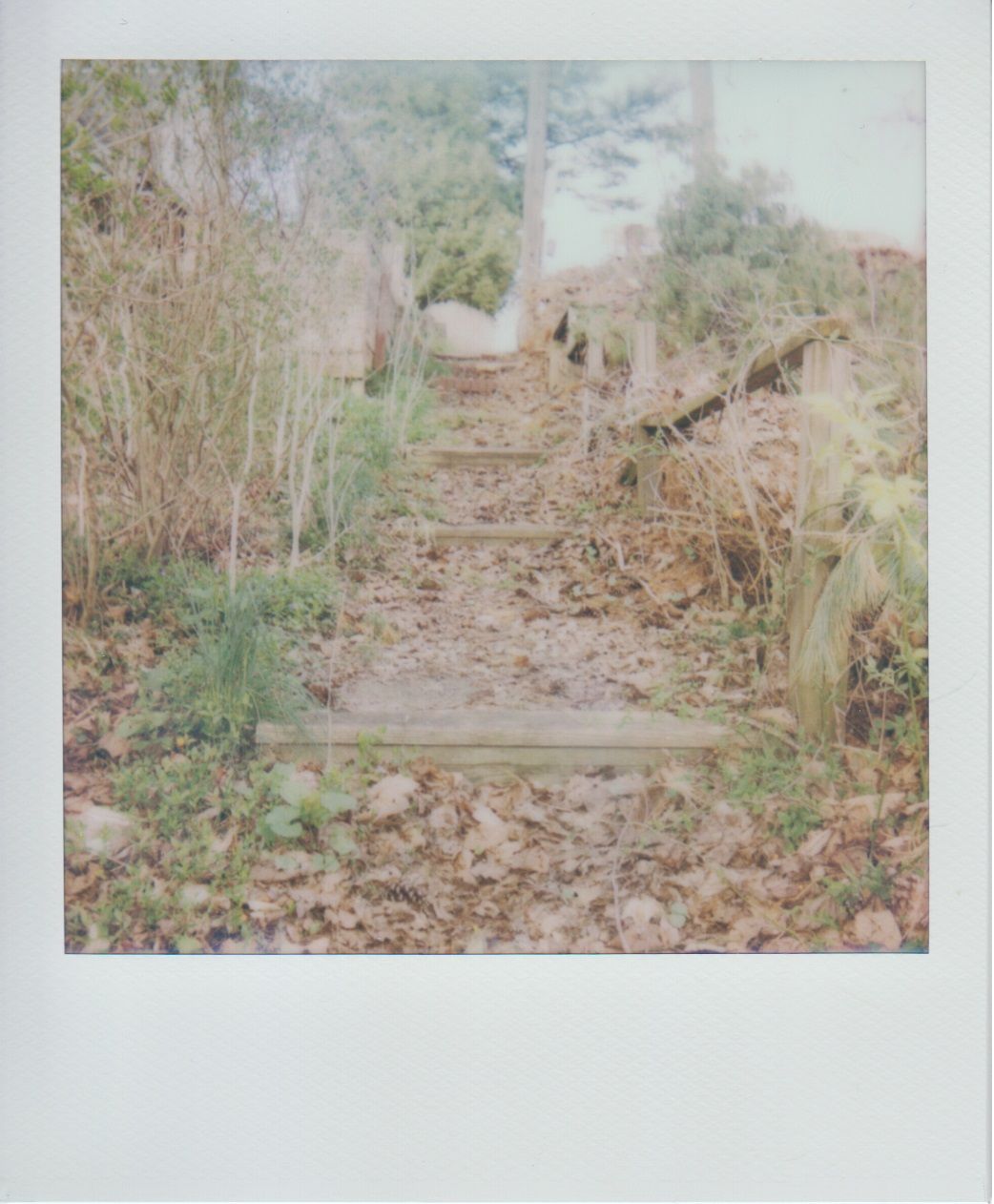

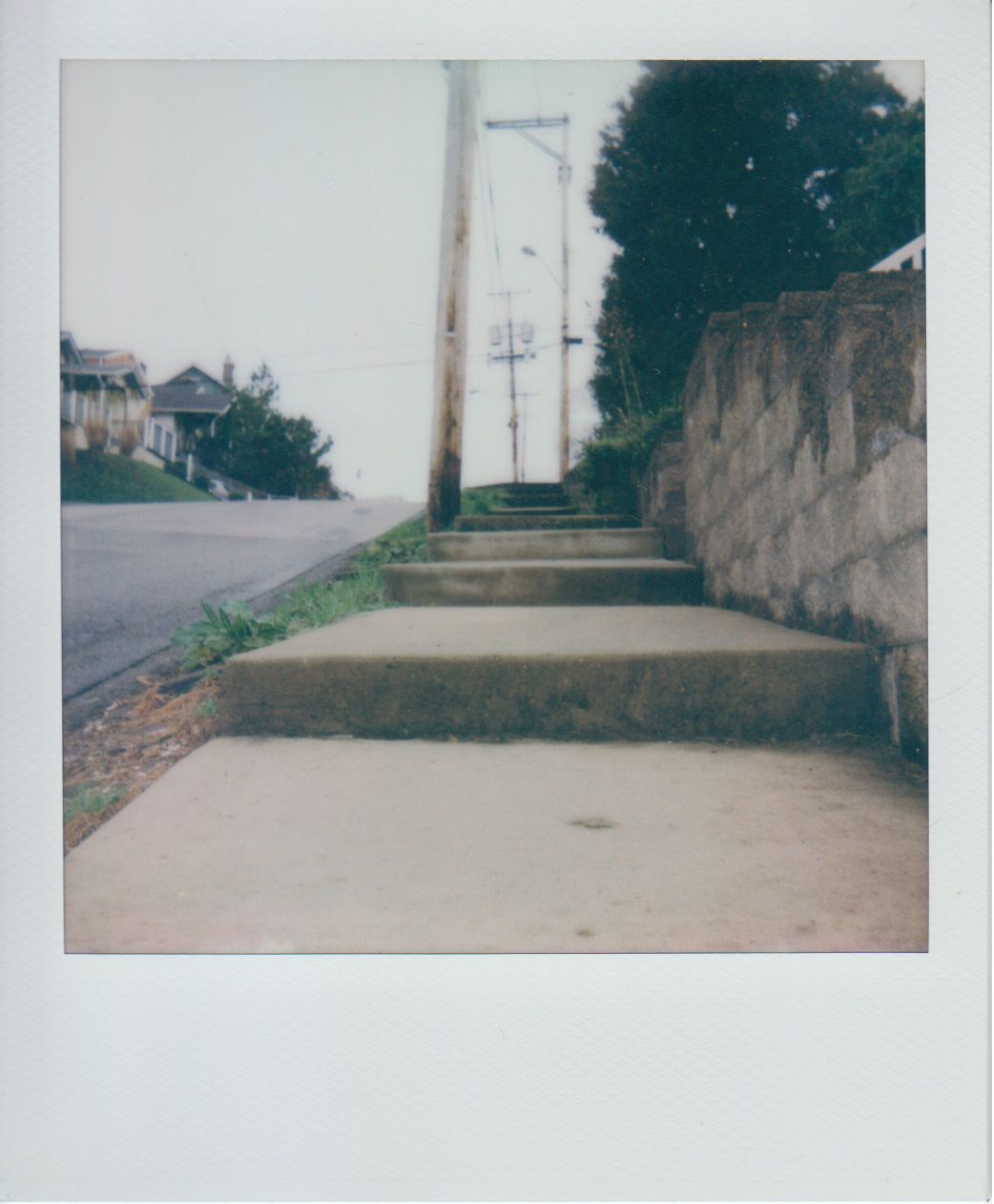
Copyright Laura Zurowski
That's cool that it was the catalyst for you to get out and explore the city. I had never really thought about stairs much while out walking, until I started getting deeper into the park system.
Since I encountered your project, I am now more aware of them and look for cool stairs everywhere!
I am still trying to figure out my angle on it though. How many stairs do you have left? And how much walking do you do per visit? Do you start further out and make a day of it?
My project is based on Bob Regan’s Pittsburgh Steps book which was written and published 20 years ago (a second edition was released 6 years ago). Bob is a GIS professor at Pitt in the engineering school and when he came to Pgh in the mid-90s he thought the city steps would offer a good mapping challenge. What he didn’t realize was that the city had all but relinquished care of the stairways due to the economic hardships caused by extreme depopulation.
So, Bob set out in his bike and armed with historical maps from the Heinz History Center and local libraries, located 739 of them! My project recreates his journey- kind of like people who follow Louis and Clark or the Oregon Trail.
Right now, I’ve visited and documented 630 flights - so I have approximately 100 left which should take me another year. For each visit I also walk around the neighborhood (if a neighborhood still remains- some streets have been reclaimed by nature as the homes were demolished decades ago). That’s always fun because I get to see what’s happening in all the various nooks and crannies around the city.
Geographically, pgh is pretty large - it once held 700,000 people- so I drive to my location and then spend time walking around. It’s in the walking and looking that the ideas come for the short story I write. I consider those stories to be “interviews” - what does that stairway and street have to say? The history here is very rich, and a lot of life has happened in these neighborhoods over the past 140 years.
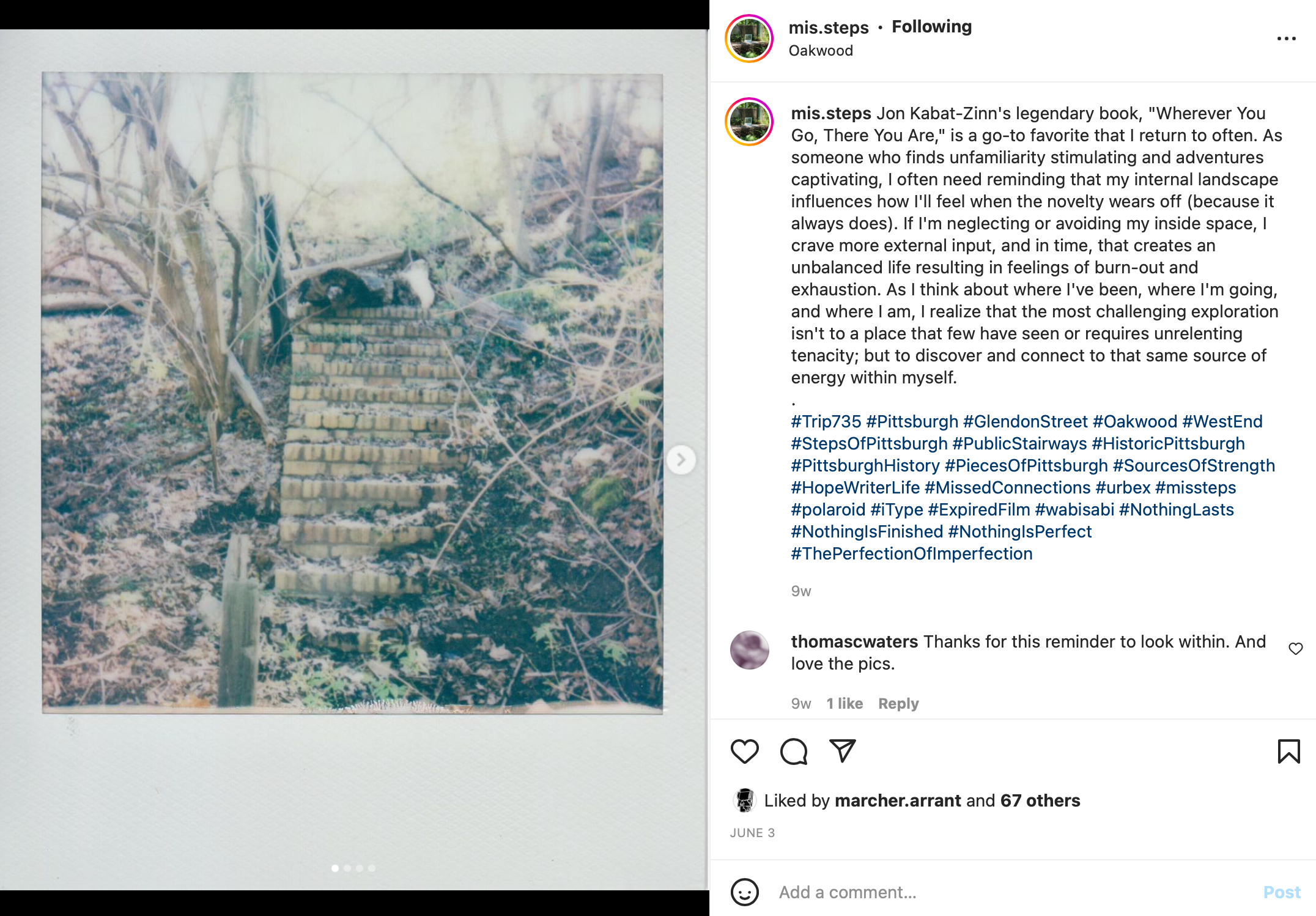
I love that you consider the short stories interviews with the stairs. The text is often topically diverse, and philosophical which I think compliments the photographs nicely.
Pairing photography and words can always be tricky but I think in a project like this one, the typographical nature of it provides a structure that makes it more flexible.
What do you find more challenging, the photography or the writing? And what have you learned about pairing the two from this project?
I've enjoyed pairing the two as it provides the opportunity to combine visuals with text - and that's a style I enjoy creating and as a viewer/reader/recipient. Over the years, the challenge has shifted. In the first year, I was very hesitant and uncertain about the writing, and I think it's quite obvious in the early pieces. About a year in, that started to change. I think some of it is attributed to "getting stronger" - kind of like what happens when one works out regularly.
I committed to a M/W/F publishing schedule (the only way a project of this magnitude could be accomplished) so that meant I have to write, edit, release, and return to writing in a nearly continuous cycle. After 4 years of traveling around that circle I feel much more accepting of myself and the pieces I write.
While the writing has become more enjoyable and relaxing, the photography aspect has increased in difficulty. I have a page on my website that details the discontinuation of Spectra film which was a major blow. (I also have a page that explains why I intentionally chose this medium if you want the back story.
I'm now working on fully expired film and it's so hit or miss in terms of how the image will look when it develops. Depending on the severity of the "color blocking" malfunction I sometimes take a second or third shot but the quality of the photos is not nearly as robust as it was when I was always using fresh film.
Now, I feel like many of the images are tired looking and fading away. I look at the decay of the film as yet another parallel with the decay of Pittsburgh's city stairs. This form of municipal infrastructure was very well built and it's held up extraordinarily well over the last 70-80+ years with minimal care. But, everything ages and gradually breaks down. Humans, stairs, film - nothing is exempt.
However, I'm marching along and will continue to use up the rest of the film I've been storing in my fridge. At this point, I can't tell if it will be enough to reach the end of the project or not. Because I never know how many usable shots I'll get out of a pack. If I run out, the final days of the project will have to be completed with something else - right now, I'm trying not to think about that!
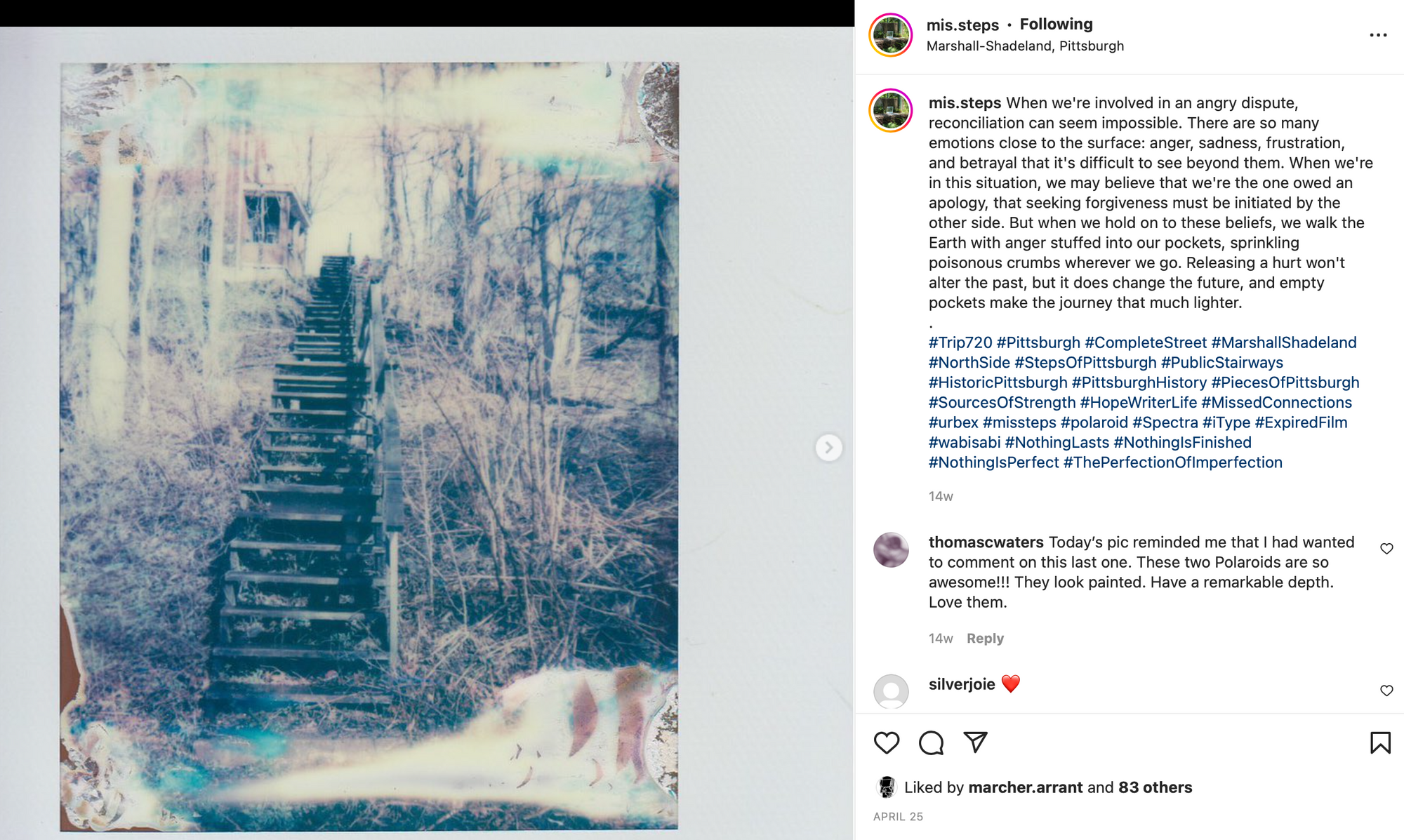
It's interesting how the project has evolved through constant iteration. Developing a process and routine is a powerful way to push creative innovation. In fact, it might be the only reason! And I like how the challenges have evolved and switched from the writing to photography.
But sticking to a schedule is very hard, and I am terrible at it. My own newsletter ebbs and flows but I keep detailed records of all my walks for a long term project, and I have found the ritual of entering all the data, and sketching a map, and then archiving it to be incredibly helpful in pushing my creativity.
Let's get back to the stairs though! I have a theory that desire paths contain secret messages from the history of people that have used them. It always fascinates me to think of all the people that have used them over the years. I even consider them oracles!
I love letting a bit of mysticism into the process to push my limits. So I am wondering if you ever pick up any strange vibrations from these places, or just have very odd experiences, like seeing strange things. Admittedly, I have not read every single entry! So my answer might be in plain site but figured I'd ask anyway.
Oh yes, I'm a firm believer that physical spaces retain energy and vibrations. With the public stairways in Pittsburgh, they were the city's first mass transportation system designed to carry the workers "from the hills to the mills" that lined the three rivers.
The city steps started to appear in the 1880s and only grew in number through the 1950s. During that time, Pittsburgh was one of the largest cities in the United States and held ~700,000 people within city limits. For many of those decades, automobiles were less common - especially for newly arrived immigrants and members of the working class, so the city steps moved all those people around in their daily life.
As people traveled the steps for work, school, shopping, worship, socializing... they carried with them their hopes and fears, desires and dreams. While life 100 years ago is quite different from what we experience today, the people who lived then were not all so different from us today.
They worried about money, pondered the meaning of life, questioned commonly held beliefs, reflected on past decisions, and tried to discern correct actions to take to help their future. People back then walked many more miles every day than we do now but that gave them time to consider these questions and reflect on the world around them.
In visiting and documenting each flight I try to walk around each space, look at the houses, the roads, the landscape, and see what comes to mind. In some spots, an image or thought immediately comes to mind and in others impressions gradually build after taking a bunch of photos.
There isn't any sort of process I follow other than to get out there and actively put myself into the environment. The walking and the looking is very intentional, I'm essentially broadcasting, "Here I am! What's going on?" :-)
And while in some spaces I've experienced more negative-leaning vibes, I've never had a negative encounter with a person I've crossed paths with. Most people are friendly, and about half are curious and want to know more about what I'm doing.
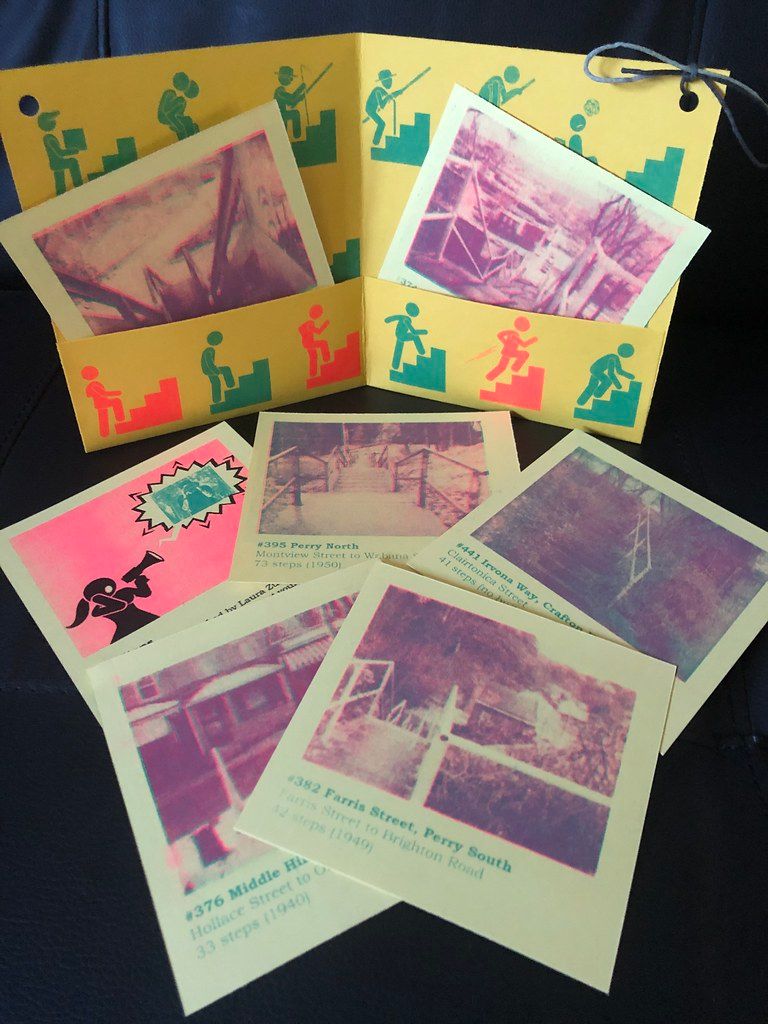
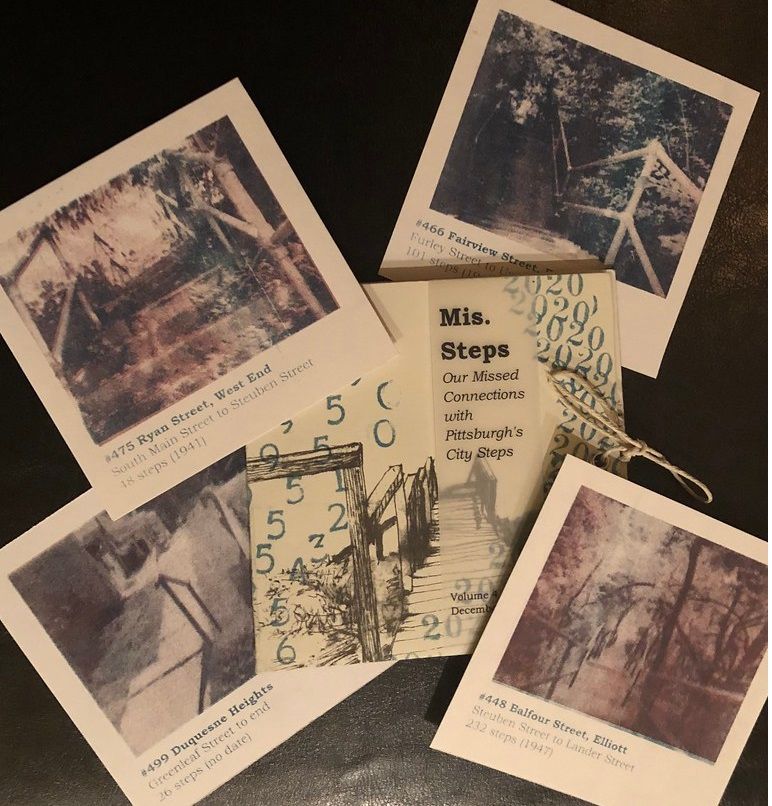
L: MIS.STEPS VOLUME 4, ISSUE 1 JULY 2020; R: MIS.STEPS VOLUME 4, ISSUE 2 DECEMBER 2020 Copyright Laura Zurowski
I really enjoy the historical background you provide! I have one final question before we wrap this up. What advice do you have to people that want to start their own project of this nature? Anything you wish you'd known before you embarked on this journey?
In terms of advice... that's tough because every person is very different. The types of projects I prefer to work on are very long-term and require consistent effort. With long-term projects you're going to have lots of blah-time, uninspired time, and feeling lazy time that you have to power through because you have self-imposed deadlines that are non-negotiable. That kind of process isn't appealing to many people, and I totally understand that!
More Interviews:
- Interview: Kwasi Boyd-Bouldin on Los Angeles, Walking and Building Projects
- Podcast: Photographer Wesley Verhoeve
- Interview: Martin Brink on Walking, Photography and Making Art During the Pandemic
I’m an artist from Saint Cloud, Minnesota. This is my newsletter on art, walking, and mindfulness. Each issue, I share new work from my projects and try to make connections between ideas, articles and people that fascinate me. You can email me at info@bryanformhals.com or follow me on Instagram & Twitter